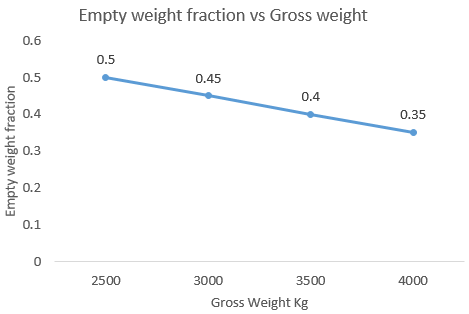This set of Aircraft Design Multiple Choice Questions & Answers (MCQs) focuses on “Conceptual Sketch Sizing – Empty-Weight Estimation”.
1. What is the typical range for empty weight fraction?
a) 0.3-0.7
b) 0.1-0.125
c) 0.14-0.28
d) 0.25-0.27
View Answer
Explanation: Empty weight fraction has typical range from 0.3-0.7 according to historical guidelines. Higher empty weight fraction indicates more weight. The range given is based on typical guideline and hence in some cases it can go beyond 0.7 as well.
2. Which of the following is the correct pair?
a) Empty weight fraction is similar to gross weight of the aircraft
b) Empty weight fraction is inversely proportion to gross weight of the aircraft
c) Empty weight fraction is directly proportion to gross weight of the aircraft
d) Empty weight fraction is not related with the gross weight of the aircraft
View Answer
Explanation: Empty weight fraction is nothing but empty weight divided by gross weight of the aircraft. Higher gross weight aircraft has lesser empty weight fraction.
3. Which of the following pair is correct based on the empty weight fraction?
a) Flying boat-0.77, Jet trainer-0.65
b) Flying boat-0.65, Jet trainer-0.77
c) Flying boat-0.45, Jet trainer-0.65
d) Flying boat-0.3, Jet trainer-1.0
View Answer
Explanation: Here, we need to think logically. The flying boat has more empty weight than the typical jet trainer aircraft. A flying boat needs to carry additional load of boat hull compare to a typical jet trainer aircraft.
4. For a typical jet following diagram is presented. What should be the average empty weight fraction for the aircraft?

a) 0.5
b) 0.35
c) 0.425
d) 0.42
View Answer
Explanation: Here, chart is shown for typical aircraft.
From chart, the average value of weight fraction = (0.5+0.45+0.4+035)/4
= 0.425
5. The design take-off gross weight of aircraft is given by _____
a) W0 = Wcrew + Wpayload + Wfuel – Wempty
b) W0 = Wcrew + Wpayload – Wfuel – Wempty
c) W0 = Wcrew + Wpayload + Wfuel * Wempty
d) W0 = Wcrew + Wpayload + Wfuel + Wempty
View Answer
Explanation: The design take-off gross weight is the total weight of the aircraft. It consists of every possible segments either it is payload or fuel. Hence, it can be seen as the addition of the all possible weight in an aircraft.
6. The empty weight fraction of a jet transport with fixed sweep is given by ______
a) 1.02*(Wo-0.06)*1.0
b) 1.5*(Wo-0.16)*1.0
c) 1.09*(Wo-0.06)*1.12
d) 1.02*(Wo-0.06)*1.04
View Answer
Explanation: The design take-off gross weight is W0 = Wcrew + Wpayload + Wfuel + Wempty
The fuel and empty weight are taken as fractions of gross weight and thus following is given as
Empty weight fraction= Wempty / W0 = A*K*(W0) c
Where, A and c are constant and dependent of type of Aircraft and K = variable sweep constant
For a typical Jet transport aircraft with fixed sweep, A = 1.02, c = -0.06 and K = 1.0.
7. A military Aircraft should be designed to have ______
a) lowest possible empty weight fraction
b) highest possible empty weight fraction
c) empty weight fraction higher than 0.89
d) empty weight fraction unity
View Answer
Explanation: One of the most important and crucial requirements of military aircraft is minimum possible weight. The lower the weight lesser the drag and lesser the thrust requirement. Hence, a military aircraft should as lightest as possible.
8. Determine the corrections or otherwise of the following assertion [A] and reason [R]:
Assertion [A]: Flying boats have higher values of empty weight fraction than that of the military aircraft.
Reason[R]: Military aircraft has to be lighter in weight.
a) Both [A] and [R] are true and [R] is the correct reason for [A]
b) Both [A] and [R] are true but [R] is not the correct reason for [A]
c) [A] is true but [R] is false
d) [A] is false but [R] is true
View Answer
Explanation: Military aircraft has to be lighter in weight is true. Flying boats are heavier than that of the typical military aircraft. The reason behind it is that flying boat has to carry extra weight of hull. Hence, [A] and [R] both correct but [R] is not the correct reason for given assertion.
9. Which of the following is true?
a) Lowest possible empty weight fraction in practice is zero
b) F-35 aircraft has the highest possible empty weight fraction
c) Empty weight fraction will be different for different type of aircrafts
d) Empty weight fraction is always same for each aircraft
View Answer
Explanation: Empty weight is weight of the power plant, avionics, sub-system of aircraft etc. Hence, in practical it cannot be zero. F-35 is a military class aircraft which is not designed to have highest possible empty weight fraction. Empty weight fraction is not constant. For, different aircraft, it will be different according to their requirements.
10. Variable sweep wings have higher empty weight fraction than that of the fixed sweep wing.
a) True
b) False
View Answer
Explanation: Variable sweep will require more effort and structural breaks than fixed sweep. Structural break will increase weight. For, variable sweep, variable sweep constant is 1.04 and for fixed sweep it is 1.0.
Sanfoundry Global Education & Learning Series – Aircraft Design.
To practice all areas of Aircraft Design, here is complete set of 1000+ Multiple Choice Questions and Answers.
If you find a mistake in question / option / answer, kindly take a screenshot and email to [email protected]
- Check Aircraft Design Books
- Apply for Aerospace Engineering Internship
- Check Aeronautical Engineering Books
- Check Aerospace Engineering Books
- Practice Aeronautical Engineering MCQs
